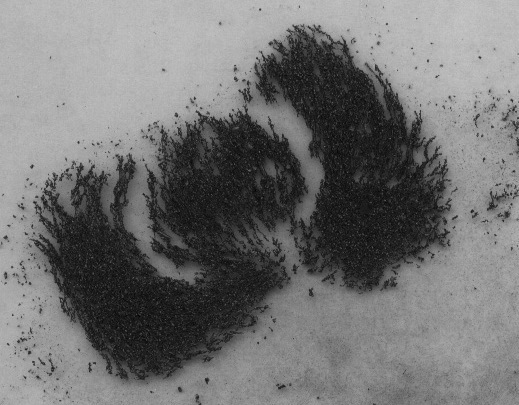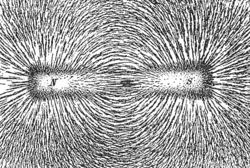![]() Michael Faraday was among the first people to conceptualize and draw the magnetic lines of force that he discovered were associated with electrical currents. Electricity was a much older concept that Faraday developed based on experiments that he used to set up for Sir Humphrey Davy (1778-1829), the renowned and important British chemist.
Michael Faraday was among the first people to conceptualize and draw the magnetic lines of force that he discovered were associated with electrical currents. Electricity was a much older concept that Faraday developed based on experiments that he used to set up for Sir Humphrey Davy (1778-1829), the renowned and important British chemist.
Philosophical Transactions of the Royal Society, 1834.
 Like Kepler's discovery of the planetary laws, Michael Faraday's discovery and description of electromagnetic fields played a key role in the electrical and magnetic scientific revolution. Oddly enough, it was a revolution that countered an important feature of the Newtonian synthesis. Gravity acts as a force that attracts objects in a straight line and is transmitted instantaneously over the space between bodies.
Like Kepler's discovery of the planetary laws, Michael Faraday's discovery and description of electromagnetic fields played a key role in the electrical and magnetic scientific revolution. Oddly enough, it was a revolution that countered an important feature of the Newtonian synthesis. Gravity acts as a force that attracts objects in a straight line and is transmitted instantaneously over the space between bodies.
Iron filings reveal the unseen magnetic field.
This phenomenon was referred to as 'action at a distance'. Kepler would have been horrified by the idea; he thought in terms of a real force emanating from the sun, affecting the planets like light and sweeping them around their orbits.
Magnetic lines of force are outlined by these metal filings.

Magnetic field lines always form circles around the current creating them.
Mathematics of electromagnetic field theory:
 James Clerk Maxwell, his calculations captured the mathematical equivalence of electricity and magnetism, through the application of the inverse square law.
James Clerk Maxwell, his calculations captured the mathematical equivalence of electricity and magnetism, through the application of the inverse square law.
"The subjects of electricity and magnetism were fully unified by means of an elegant and consistent description of electromagnetic phenomena."
"Maxwell's equations also required the existence of waves of higher frequencies than those of visible light (ultraviolet rays, x-rays, and gamma rays) and of lower frequencies (infrared, microwaves and radio waves) than the visible."
Murray Gell-Mann, Quark and the Jaguar, pp. 80-82.
"All around us are facts that are related to one another…. They begin to make some sense. The world becomes a more comprehensible place."
Steps to depth of vision:
sympathetic rhythm "similar things must be connected" (89)
Volts [ potential ] and amps for Amperes [current] are related to watts:
watts = volts x amperes.
Have students record the watts, volts and amperes that they determine from appliances.
A flow of electrons, electron bonds, static electrical currents.
 |
||
|---|---|---|
| Tools of Toil: what to read. | ||
| Tools are historical building blocks of technology. | ||